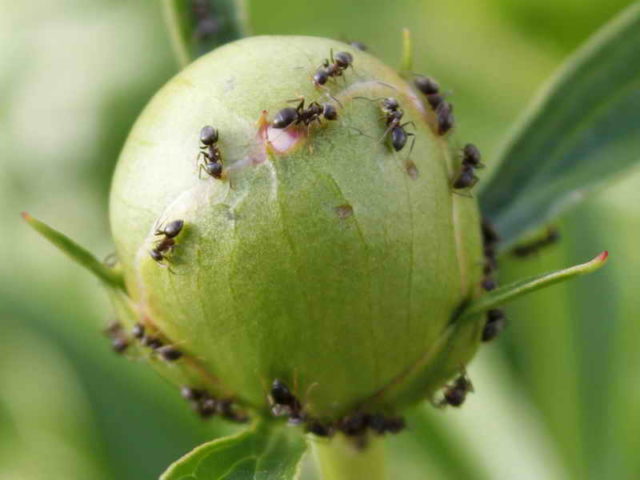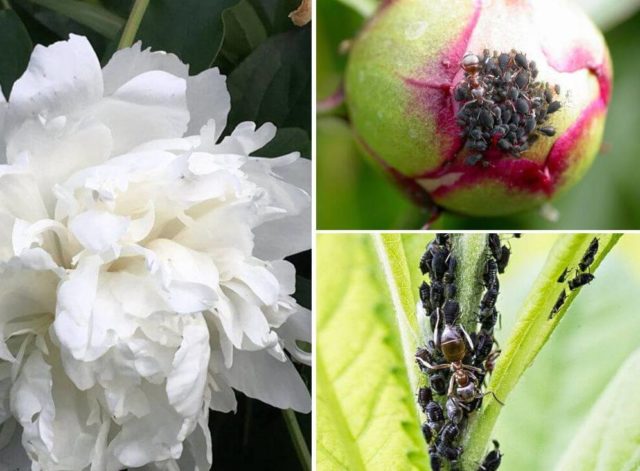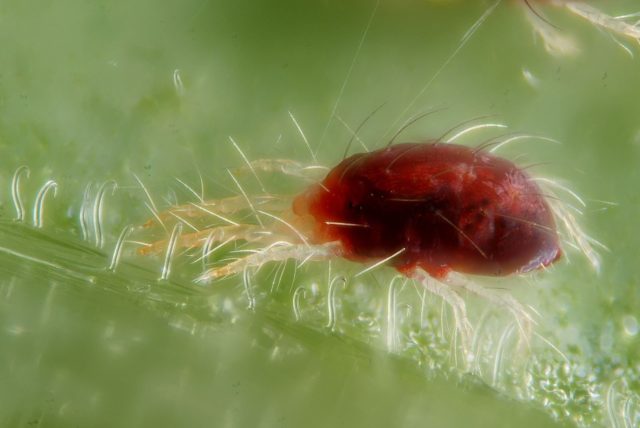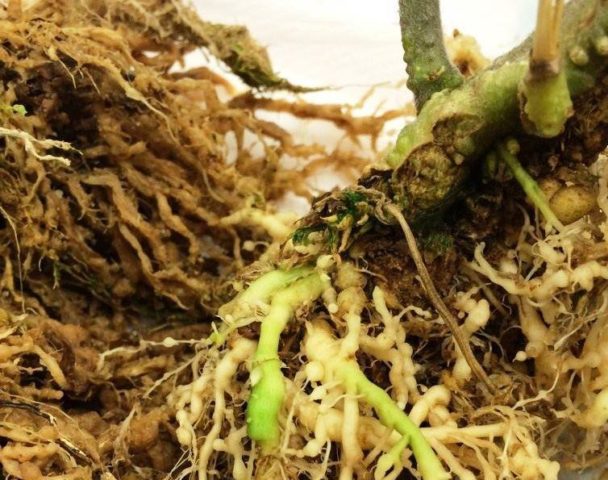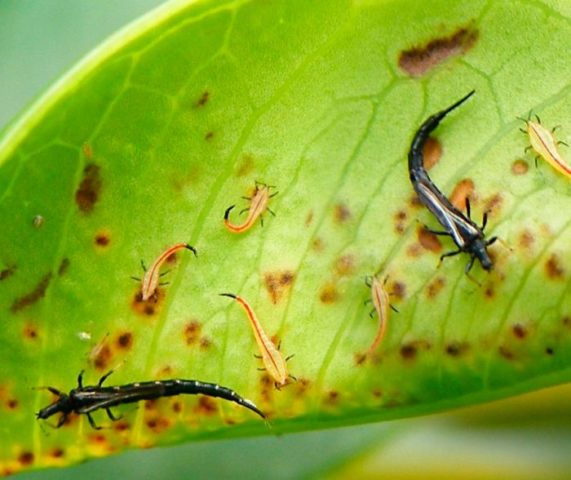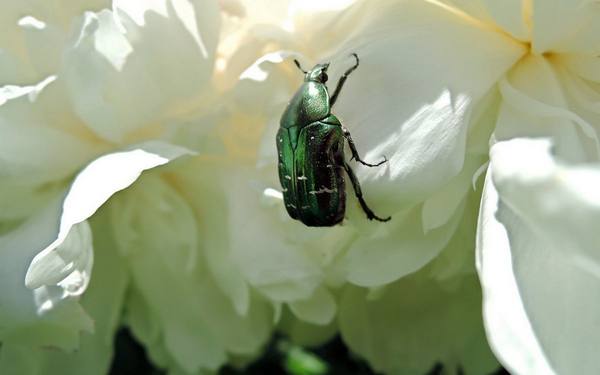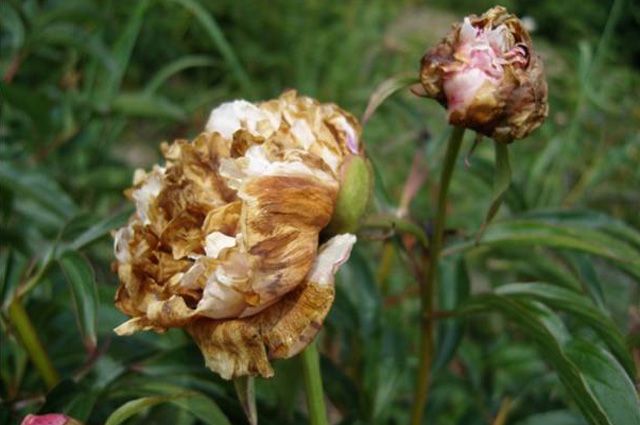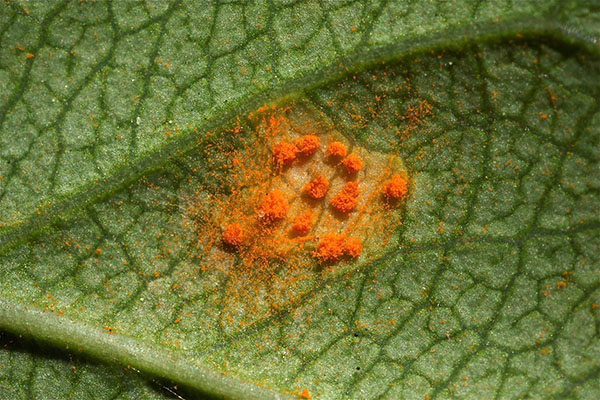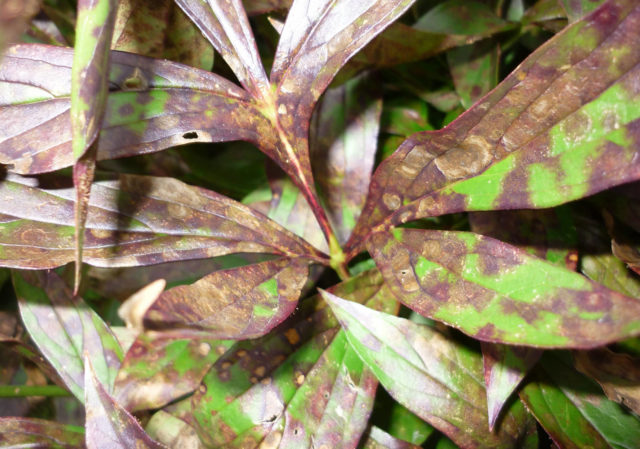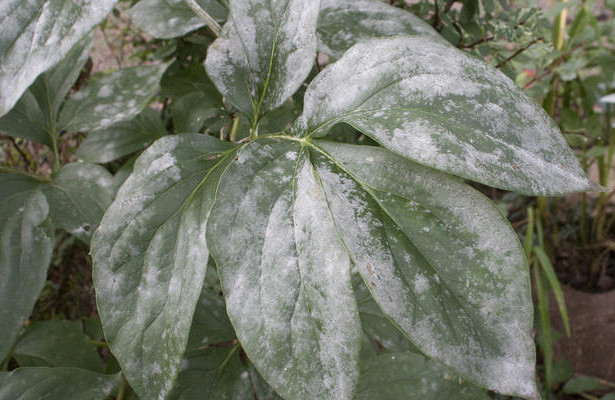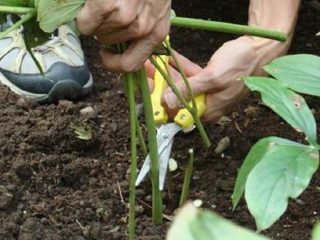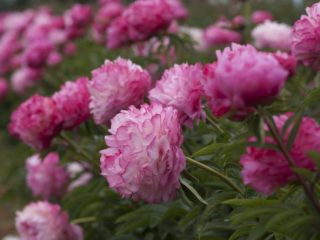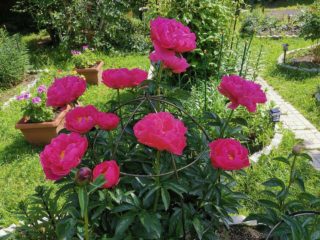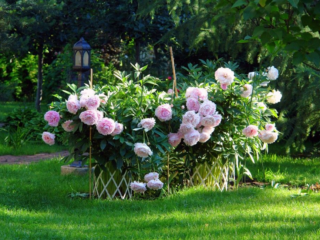Content
Peony Mathers Choice was bred by American breeders in Glaskok in 1950. The name of the variety is translated as "Mother's Choice". Due to its excellent decorative properties, easy care and minimal requirements for growing conditions, Mathers Choice was recognized by the American Peony Society as the best cultivar in the world among varieties obtained as a result of selection, and in 1993 was awarded a gold medal.
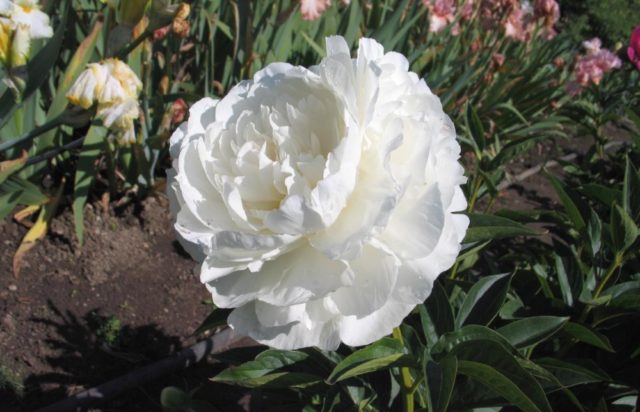
The Mathers Choice variety has excellent decorative properties and a pleasant floral aroma.
Description of peony Mathers Choice
The straight stems of a beautiful plant grow up to 70 cm in height. They are so strong that they do not need additional support during flowering. The bushes are covered with small dark green leaves. Growing up, the variety takes up a lot of space on the site. The height of the bush is from 60 to 150 cm.
Like all peonies, the Mathers Choice variety is photophilous and, being constantly in the shade, can die. The herbaceous plant has a high frost resistance and therefore takes root well not only in the central part of Eurasia, but even in regions with cold winters and a harsh climate. The peony is suitable for growing in the territory belonging to the 4th zone of frost resistance - in the Moscow region, in most of Russia, as well as in the mountainous and northern regions of Scandinavia.
Flowering features
The lactic-flowered variety Mathers Choice is double-pink, with tall, dense, symmetrical, pure-white buds. Medium-sized inflorescences reach 15 cm in diameter and have a creamy shade inside, giving the bushes a special grace. The edges of the petals are sometimes crimson.
A year after planting, the peony will decorate the garden plot with lush milky flowers.
The herbaceous peony Mathers Choice is characterized by a medium-late period of bud formation. The period falls in May-June and lasts 2-3 weeks. The buds are laid in late July or early August. The buds have a pleasant floral scent and last a long time both in the garden and in the cut. The inflorescences look voluminous due to the many densely spaced petals.
Moderate watering, mulching and adherence to the rules when applying fertilizers will create favorable conditions for the intensive flowering of the Mathers Choice peony and the formation of beautiful white buds.
Application in design
The variety is medium-sized and can be used both as individual ornamental plantings, and in combination with other plants as a beautiful element of existing flower beds.
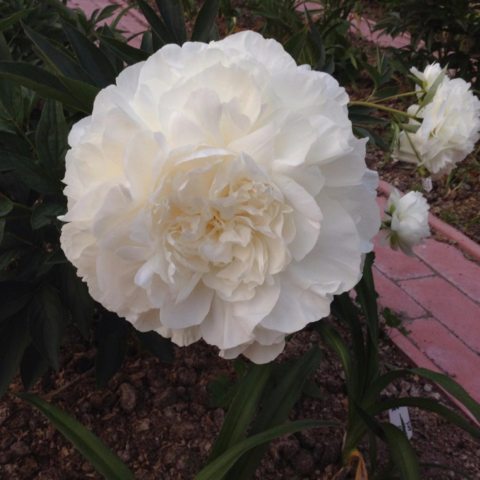
Perennial flowering lasts up to 15 years, subject to constant growth in one place without transplanting
Peony Mathers Choice retains its attractive appearance even after the end of flowering, therefore, it will decorate not only flower beds, but also borders. But this variety is not suitable for planting on balconies and loggias. Shrubs will not be able to grow in conditions of tightness and insufficient sunlight.
In an open area for a Mathers Choice peony, it is undesirable to be adjacent to plants with a highly developed root system. Lilacs, hydrangeas, as well as any trees will interfere with the peony in receiving nutrients and water in the required amount.
Flowers of the buttercup family are also incompatible with peony plantings. Adonis, anemone, hellebore, lumbago quickly deplete the soil. In addition, their roots secrete substances that inhibit other flowers.
It is good to decorate small areas with a flower bed of roses and peonies. In the spring, you can add any bulbous seasonal flowers to them. So the flower bed will not seem empty. Peonies go well with tulips. After flowering is complete, asters, chrysanthemums, phloxes, lilies, petunias and astilbe brushes will look appropriate against the background of foliage.
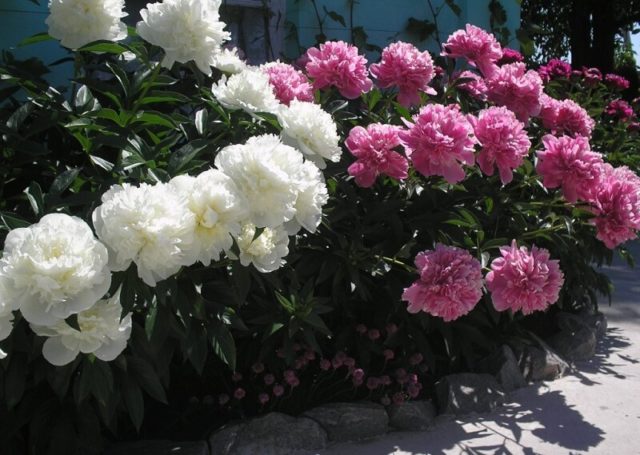
Peonies blend well with other flowering shrubs with similar requirements for growing conditions
Reproduction methods
The Mathers Choice variety is propagated by dividing the tubers. Autumn is the most suitable period. Pre-selected, healthy, adult specimens are dug out of the soil and carefully cut into several parts so that each of them has 2-3 buds. Peony roots are strong enough to use a sharp knife or saw. To prevent the cut parts from decaying, the cuts should be treated with a charcoal-based mixture.
Less commonly, for propagation of the peony of the Mathers Choice variety, the method of green cuttings is used. For this, the stem is separated with a part of the root collar. This method is not effective as it can weaken the mother bush.
The root cuttings method is quite lengthy. When using it, a part of the root no more than 10 cm long is buried in the ground, on which buds will gradually appear.
On peonies of the Mathers Choice variety, seeds are very rarely tied, therefore, the plant is not propagated in this way.
Landing rules
Late summer and early autumn are the best times to plant Mathers Choice peonies. In this case, the shrubs will have time to take root before the arrival of cold weather. If planted in springtime, this should be done before the plant awakens. But peonies will no longer be able to bloom this year.
Tubers prepared for planting in the soil must be pre-dried and cut with manganese solution or charcoal. This will protect the plant from rotting and getting into the root of various infections.
Great importance should be given to the choice of the landing site. Peony Mathers Choice is a light-loving plant, so the site should not be in the shade.
Excessive moisture can lead to the death of flowering shrubs. To avoid this, it is recommended to drain the soil with the following materials:
- expanded clay;
- foam crumb;
- sand;
- chopped pine bark;
- charcoal;
- peat.
Well-drained soil provides free oxygen access to the roots. The introduction of drainage protects the soil from sudden changes in temperature and prevents the development of fungal diseases of the root system.
The depth and width of the planting pits should be at least 50-70 cm. A nutrient mixture prepared from compost or rotted manure is placed in the lower 2/3 of the part. Peony tubers Mathers Choice are planted in the upper 1/3 of the pit without fertilizers, sprinkled with soil and watered abundantly, spending 5 liters of water for each bush. A little dry soil is poured on top again.
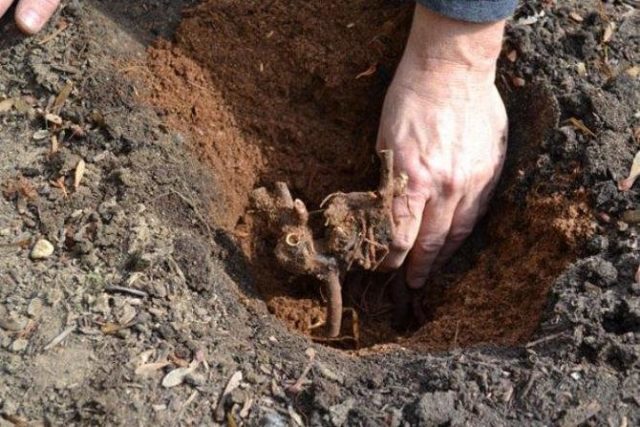
Well-fertilized planting pits will create a supply of nutrients for the successful wintering of peonies and the development of the root system in spring
Follow-up care
In the first year after planting, caring for young seedlings of Mathers Chois peonies consists in timely watering, loosening and fertilizing. It is necessary to monitor the process of soil subsidence. If the roots of the peonies are exposed, they are sprinkled with a sufficient amount of earth.
Watering is carried out regularly to the entire depth of the roots. It is especially important to maintain an optimal level of moisture in the summer. For adult bushes, you need to spend 2 buckets of water several times a week.
It is recommended to loosen the soil regularly. This should be done with care so as not to damage the root system of Mathers Choice peonies. It is important to remove weeds from the site in a timely manner, as they intensively absorb nutrients from the soil.
In the first year of life after planting, the cut roots have almost no reserves of nutrients. Therefore, it is recommended to feed young peonies Mathers Choice from the moment of emergence until the beginning of July.
Mullein solution is one of the most common and affordable feeding methods. It promotes the rapid development and growth of the root system, the formation of leaves, shoots and replacement buds.
In the absence of a mullein, you can feed Mathers Choice peonies with an interval of 2 weeks, using a full mineral complex.
When aerial vegetation appears, peonies are watered with a solution obtained from 50 g of urea, diluted in 10 liters of water.
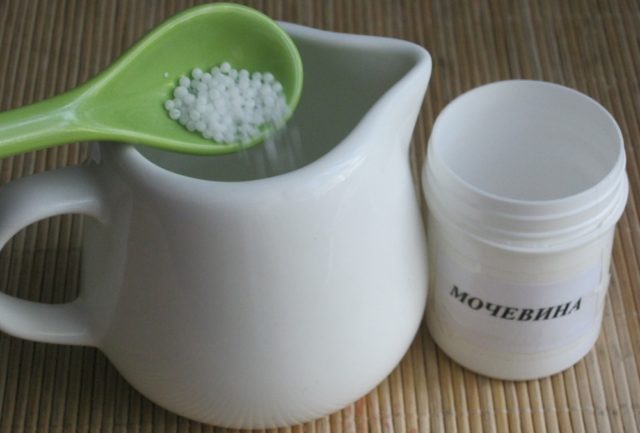
Foliar feeding of Mathers Choice peonies with urea in the first year is mandatory, since it consists of 47% nitrogen, which is necessary for plant growth
To protect the soil from weathering, washing out and freezing of roots in winter, it is recommended to mulch it using sawdust, straw or cut grass.
Mulching creates favorable conditions for the effective growth and development of Mathers Choice peonies.
Preparing for winter
After the onset of the first frosts, the aboveground part of the shrubs lies on the ground, only after that it should be completely cut off to the level of the soil.
The variety is frost-resistant and does not need shelter for the winter.
Pests and diseases
The main pests that Mathers Choice peonies suffer from are:
- Ants. Penetrating into the inflorescences, insects damage and deform them. Such buds will no longer be able to bloom.
Ants attracted by sweet nectar can carry various fungal infections
- Aphid - small bugs of black or green color. They settle on the tops of the shoots, as well as around the buds.
Numerous colonies of aphids feed on plant sap, depriving them of vitality
- Spider mites - very small insects, about 1-2 mm in size, red, orange, yellow-green or milky-transparent.
Malicious pests initially settle on the back of the leaves, entangling them with cobwebs
- Nematodes - worms that damage the roots of Mathers Choice peonies.
The presence of nematodes is identified by nodular swelling on the roots.
- Thrips - black elongated bugs, ranging in size from 0.5 to 1.5 cm.
Thrips are the cause of wilting of young shoots, pests inflict the greatest damage on Mathers Choice peonies during budding
- Bronzovka - the gluttonous beetle feeds on the stems, leaves and petals of peonies.
The back of the bronze beetle is green with a metallic sheen
Timely detection of signs of pest activity and treatment of shrubs with protective agents will prevent the death of peony plantings.
The Mathers Choice variety is often subject to the following diseases:
- Gray rot. Fungal disease begins with the formation of brown spots around the peduncle in the area of the root collar. The stems in these areas rot, dry out and break.
Buds infected with gray mold turn brown, bloom poorly, taking a one-sided appearance, dry up and fall off
- Ring mosaic. Yellow-green rings and stripes appear on the leaves of peonies.
The spots, merging with each other, form a marble pattern on the surface of the leaves.
- Rust. Easily identified by the formation of yellow spore pads on the underside of leaves after flowering.
Rust infects the leaves of Mathers Choice peonies and progresses after flowering is complete.
- Brown spot stains foliage and buds in an uneven brown color.
The first signs of the disease appear at the beginning of summer in the form of elongated spots on the leaves, gradually covering the entire plant, from which the shrubs take on a burnt appearance
- Powdery mildew manifests itself in the form of a white cobweb bloom on the entire surface of the tissues of shrubs.
Fungal disease affects only adult peonies, the leaves of which are deformed and dry out
To effectively combat diseases, preventive spraying of Mathers Choice peonies with special preparations, for example, copper oxychloride, should be carried out. Do not allow the petals to fall on the leaves, as spots of gray rot may appear on them from dew or high humidity.
Failure to comply with the watering regime and excessive rainfall will lead to rotting of the buds. The creation of drainage channels to drain rainwater will help solve this problem.
Buds that have lost their decorative appearance should be cut to the first green leaf and unnecessary vegetation removed from the site.
Conclusion
Peony Mathers Choice, despite its American origin, has recently been gaining more and more popularity among Russian flower growers. The decorative appearance, easy maintenance and undemanding to natural and weather factors create favorable conditions for the cultivation of this beautiful herbaceous perennial in various regions of Russia.
